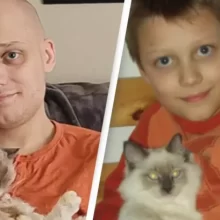Vanished in Plain Sight: The Heartbreaking Reality Behind Joyce Vincent’s Story
In the heart of a bustling London, a story unfolded that would leave the city and, indeed, the world, grappling with a myriad of emotions—bewilderment, sorrow, and an unsettling reflection on the nature of our social bonds. This is the tragic tale of Joyce Carol Vincent, a woman whose life came to a silent, unnoticed end within her own apartment, her existence fading from the world’s consciousness for over two years. The discovery of Joyce’s fate sent ripples through the community, challenging our perceptions of connection, isolation, and the invisible threads that tie us together—or sometimes, sadly, fail to do so.
Joyce Vincent was not a character from a bygone era, lost to the annals of history, nor was she a recluse who had severed all ties with society. She was a 38-year-old woman, with a career, family, and friends, living in an era where communication technologies were burgeoning, making it seemingly impossible for someone to simply vanish from the lives of those who knew her. Yet, vanish she did, in a story that unfolds like a modern-day mystery, revealing the complexities of human relationships and the thin veneer of connectivity that modern life offers.
This article aims to peel back the layers of Joyce Vincent’s story, exploring not just the how and the why of her tragic end, but also reflecting on the broader implications it has for our understanding of community, connection, and the importance of maintaining genuine relationships in a world that is increasingly connected yet paradoxically more isolated. Through a journey into her life, her isolation, and the aftermath of her discovery, we’ll explore what Joyce’s story teaches us about the essential human need for connection and the stark reminder that, in the end, it’s the depth, not the breadth, of our relationships that truly matters.
The Discovery of Joyce Vincent
The scene inside Joyce Vincent’s apartment was a stark contradiction—a snapshot of everyday life frozen in time, juxtaposed against the grim reality of a life unnoticed and lost. It was January 2006 when officials from a north London housing association entered her apartment to repossess it due to unpaid rent. What they found was a home that looked as though it could be anyone’s, with unopened mail piled by the door and a sink full of dishes, the television still playing BBC1. Christmas presents, wrapped and ready, sat unattended, waiting for a festive celebration that would never come. Amidst this scene of paused life, Joyce Vincent herself was found, but in a state far removed from the vibrant woman she once was. Her body, almost entirely decomposed, lay on the floor, holding onto a shopping bag—a skeletal reminder of the life that had once filled the space.
Vincent’s apartment, a bedsit in a type of social housing, held no signs of a struggle or sudden departure. It seemed as though life had simply stopped, leaving behind the eerie glow of a television as the only sign that someone had once lived there. Joyce had been dead for just over two years, her last moments dating back to sometime in December 2003. The mystery of her unnoticed absence began to unfold, revealing a troubling question: how could a woman with family, friends, and a life filled with the usual social ties become so disconnected that her death went unnoticed for such an extended period?
Neighbors, it turned out, knew little about Joyce. The only hint that something was amiss was a persistent bad smell, attributed to the garbage bins below rather than a decaying human body mere feet from their own doorsteps. Joyce Vincent’s life and death painted a picture of profound isolation—a woman living among others, yet invisible in her most critical time of need.
This discovery forces us to confront uncomfortable questions about the nature of our connections to each other. In the bustling metropolis of London, amidst the constant flow of human activity, Joyce Vincent faded from view, her absence a silent void that went unfilled and unnoticed. Her story begins with this tragic end, leading us to delve deeper into the life of a woman who was much more than the circumstances of her death.
Joyce Vincent’s Life and Isolation
Image Source: cultprojections
Joyce Carol Vincent’s life, before its silent fade, was marked by the ordinary and the extraordinary, a tapestry of experiences and choices that, from the outside, mirrored the lives of many. Born on October 19, 1965, in London’s Hammersmith district, Joyce was the youngest of five sisters, the only one residing in the United Kingdom. Her early life was touched by loss; her mother passed away when she was just a child, leaving her in the care of a father who worked as a carpenter. Despite these challenges, Joyce embarked on a path that would see her securing a position at Ernst & Young, one of the world’s largest accounting firms—a testament to her ambition and capability.
However, beneath the surface of this seemingly successful life, there were currents of isolation and perhaps, discontent. Joyce’s departure from Ernst & Young in 2001 was shrouded in mystery; she left without giving a clear reason, with colleagues recounting conflicting stories about her next steps. Some said she planned to travel with a group, while others believed she had been headhunted for another job. This pattern of abrupt changes wasn’t limited to her professional life; Joyce’s personal life was characterized by a series of moves from one flat to another across London, a physical manifestation of the restlessness that perhaps mirrored her internal state.
Her relationships, too, were transient. Joyce didn’t maintain a close circle of friends but instead moved within the orbits of those she met through boyfriends, colleagues, or flatmates. This nomadic existence extended to her family connections; she became increasingly isolated from her siblings, not answering calls from her sister, a distance that grew until it became a chasm.
In the years leading up to her death, Joyce’s life took a turn that few were aware of. She spent time in a shelter for victims of domestic violence, a stark revelation that sheds light on the complexities of her relationships and the potential struggles she faced. The reasons for her withdrawal from family and the choices that led her to such isolation remain largely speculative, but they paint a picture of a woman navigating life’s challenges with an increasing sense of solitude.
The juxtaposition of Joyce’s external success and her internal isolation raises poignant questions about the nature of social ties and the ease with which someone can slip through the cracks of our social safety nets. Her story is a reflection on the importance of meaningful connections, the kind that persists beyond surface-level interactions and delves into the realm of genuine understanding and support.
The Enigma Surrounding Her Death
The circumstances of Joyce Vincent’s death cast a spotlight on the fragility of human connections in the modern world. When officials discovered her body, it was the stark finality of a life that had quietly slipped away from the collective consciousness of her community, her friends, and even her family. The investigation into her death provided few answers; with her remains too decomposed to ascertain a cause, speculation abounded. Police suggested she might have died of natural causes, perhaps an asthma attack, a theory supported by her known condition, but no definitive conclusion could be reached. The criminal investigation ruled out foul play, leaving a haunting question: How did Joyce Vincent die alone and unnoticed?
This question underscores a chilling reality of urban life and social disconnection. Joyce had been a part of the bustling city of London, a place where anonymity can be a refuge but also a peril. Her isolation became complete in death, a silence that lasted over two years, a period during which the world moved on unaware of her absence. It raises the unsettling notion that in our interconnected age, it is still possible to vanish without a trace, to become a whisper in the noise of daily life.
The enigma of Joyce Vincent’s death is not just in the how and why she died but in the profound solitude that marked her final days. It challenges us to reflect on the nature of our relationships and the depth of our engagements with those around us. Joyce’s story is a stark reminder of the need for a community that looks beyond the surface, that pays attention to those who might be struggling in silence.
The Impact of Joyce Vincent’s Story
The documentary “Dreams of a Life” by filmmaker Carol Morley brought Joyce Vincent’s story into the public eye, transforming her from a forgotten soul into a symbol of societal neglect and the complexities of human connection. Morley’s quest to understand Joyce, to give her a voice posthumously, opened up a broader conversation about loneliness, isolation, and the invisible barriers that can separate us even in the midst of a crowded city.
Through interviews with people who had known Joyce, including Martin Lister, a former boyfriend, the documentary pieced together a portrait of a woman who was both vibrant and troubled, engaged in the world yet profoundly alone. Lister’s shock upon learning of Joyce’s fate years after her death spoke volumes about the ease with which individuals can drift apart, the unasked questions that remain hanging, and the assumptions we make about the lives of others.
The impact of Joyce Vincent’s story goes beyond the tragedy of her death; it serves as a poignant reminder of the importance of maintaining connections. It challenges the viewer to consider the role they play in the lives of those around them, to question whether we are truly present for our friends, family, and neighbors, or if we too could overlook someone in need. Joyce’s story is a call to action—a reminder to reach out, to listen, and to ensure that no one is left to face life’s challenges in isolation.
As we reflect on Joyce Vincent’s life and the circumstances of her death, we are compelled to confront the realities of our social existence and the responsibilities we bear towards one another. Her story, as sad as it is strange, is a mirror held up to society, asking us to examine the depth of our connections and the strength of our communal ties.
Maintaining Connections in a Disconnected World
In a world that seems more connected than ever before, the tragic story of Joyce Vincent starkly reminds us of the importance of fostering and maintaining genuine relationships. Here are practical tips to ensure that we not only stay connected with those around us but also provide a safety net for those who might be slipping into isolation.
Check-in Regularly
Make It a Habit: Schedule regular check-ins with friends and family, whether through a phone call, text message, or in-person visits. Consistency is key to maintaining strong connections.
Be Present: In your communications, be fully present. Listen actively and engage deeply, showing genuine interest in their lives and well-being.
Recognize Signs of Isolation
Know the Signs: Withdrawal from social activities, a lack of interest in things once enjoyed, or a decline in communication can all be signs someone is struggling.
Offer Support: If you notice someone pulling away, reach out to them. Offer your support without judgment, letting them know you’re there for them.
Foster Community Connections
Engage in Community Activities: Encourage participation in community events or activities. These can be great ways for people to feel a part of something larger and reduce feelings of loneliness.
Volunteer Together: Volunteering not only helps the community but can also strengthen bonds between individuals and create new connections.
Leverage Technology Wisely
Use Social Media Positively: While it’s easy to get caught up in the superficial aspects of social media, use these platforms to foster genuine connections by sharing meaningful content and engaging in real conversations.
Video Calls: Whenever possible, opt for video calls over text messages. Seeing each other’s faces can create a stronger sense of closeness and connection.
Encourage Open Conversations
Create Safe Spaces: Foster an environment where friends and family feel safe to share their feelings, struggles, and concerns without fear of judgment.
Be Vulnerable: Sharing your own experiences and vulnerabilities can encourage others to open up, strengthening the trust and bond between you.
Embracing Connection: A Call to Action from Joyce Vincent’s Legacy
Joyce Vincent’s story is a poignant reminder of the fragility of life and the essential need for community and connection. It underscores how easy it can be to slip through the social safety net, even for those who seem to be well-integrated into the fabric of society. Her story, brought to light by the documentary “Dreams of a Life,” has prompted a necessary conversation on isolation, loneliness, and the collective responsibility we share in ensuring no one is left behind.
Let us carry forward the lessons learned from Joyce Vincent’s life and death. It’s a call to action for all of us to be more vigilant and caring towards those around us. By actively engaging with our community, checking in on our loved ones, and fostering environments where open and honest conversations can flourish, we can hope to prevent such tragedies from occurring in the future.
In remembering Joyce, let us also remember the countless others who may be silently struggling, hidden in plain sight. Let their stories inspire us to build stronger, more compassionate connections with those around us. After all, it’s through our shared humanity that we find our greatest strength and the ability to make a real difference in each other’s lives.
This article, inspired by the tragic yet eye-opening story of Joyce Vincent, serves not only as a tribute to her memory but also as a guide to living a life filled with meaningful connections. It’s a reminder that in our increasingly disconnected world, the simple act of reaching out, of showing care and concern, can make all the difference. Let’s not wait for another story like Joyce’s to remind us of the value of connection. Instead, let’s make a conscious effort, starting today, to ensure that everyone in our circle feels seen, heard, and valued.
The post Vanished in Plain Sight: The Heartbreaking Reality Behind Joyce Vincent’s Story appeared first on Healthy Holistic Living.












